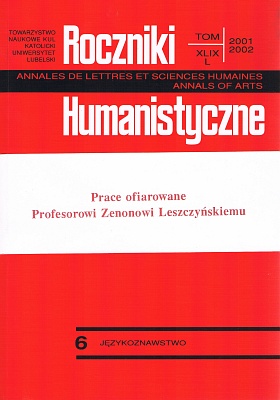Leśmian and Leszczyński − Two Poles of the Anthroponymic Forest Family
Abstract
Both titular names belong to the family of numerous morphological-semantic types of personal names based, directly or indirectly, on the noun las (forest) and its derivatives. Either of the two names has occurs differently: the first one is exceptional, the second is a name of the highest statistic rank among all “forest” anthroponyms.
The word Leśmian is a name associated mainly with our prominent poet (1878-1937). It is a phonetic Polonization of Lesman, which in turn can be interpret as a calque of the Polish word leśnik (a man of the forest). The word Leśmian is also a name independent of the artificial name of the poet in question. It is secondary to Leśnian, a term that means a man living in a forest or coming from it, cf. Łęczyczan: Łęczyca, Zagorzan: Zagorze. The change Leśnian > Leśmian is accounted for as a manifestation of over-correctness against the background of the instability of consonant repartition m', n' in some Polish dialects (e.g. niasto<mniasto< miasto, niska<mniska<miska), cf. toponyms Gołynino>Gołymino, Uniemino>Humienin.
The name Leszczyński is not uniform with respect to word-formation: Leszczyń-ski or Leszcz-yński. This lack of uniformity deals with both the formant: -ski or -yński, and the toponymic basis: Leszczyna(-y)(-o), Leszcze in the singular of plural forms Leszcznica>Lśnica, Leszczyniec, Leszczka, Leszczków, Leszczno(-a)>Leszno(-a) or even Leśna, the toponymic or anthroponymic: Leszczyn, Leszczka or the appelative form: leszczyna, leszczka, leszcze “leszczyna” (hazel). The basis for the same anthroponyms with somewhat later, Mid-Polish metrics could the toponyms Leszczyn(o), Leszcze in the singular and plural cases, Leszcznica, Leszczno or anthroponyms Leszcz, Leszczyn connected with the word leszcz (a kind of fish - bream), or this appelative could directly become this term. The name was well-known from the end of the fourteenth century onward, primarily as a noble name (high church and state official − including the king), and then became popularized in the remaining social states.
Copyright (c) 2002 Roczniki Humanistyczne

This work is licensed under a Creative Commons Attribution-NonCommercial-NoDerivatives 4.0 International License.





